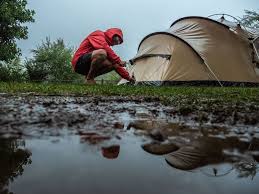Camping in the Rain:A Novel Experience
Camping is an adventure that brings us closer to nature, offering a unique escape from the daily grind. However, unexpected rain can often dampen the spirits of even the most enthusiastic campers. The key to turning a rainy camping trip into an enjoyable and memorable experience lies in preparation, the right gear, and maintaining a positive attitude. In this comprehensive guide, we explore essential tips and strategies to help campers make the most of a wet and wild outdoor adventure.
Before heading out on a camping trip, it is essential to check the weather forecast. If rain is expected and you prefer dry conditions, rescheduling may be the best option. However, if postponing isn’t feasible, preparing for wet conditions with appropriate gear and mindset will make a significant difference.
Wearing the right clothing is crucial for staying warm and dry. Cotton is not ideal for wet conditions as it absorbs moisture, leaving campers feeling cold. Instead, opt for synthetic or wool base layers, which wick moisture away from the body and dry quickly. Additionally, a high-quality rain jacket, rain pants, and waterproof boots will help keep the body dry. Packing extra dry socks and layering appropriately will provide added warmth and comfort.
Keeping camping gear dry is just as important as staying dry yourself. Waterproofing strategies include:

A reliable, waterproof tent with a well-fitted rainfly is essential for rainy camping conditions. Choosing a tent with additional vestibule space will allow for the storage of wet gear without compromising sleeping quarters. Additionally, bringing a ground tarp can prevent moisture from seeping into the tent from below.
Choosing the right campsite can mean the difference between a dry and comfortable night and a soggy, miserable experience. Campers should:
To minimize exposure to rain, consider setting up a tarp overhead before pitching the tent. If possible, set up the tent during a break in the rain or under shelter. Properly staking the rainfly and ensuring good ventilation will help prevent condensation buildup inside the tent.
A wet sleeping bag can ruin a camping experience. To prevent damp conditions, campers should:
Cold, wet conditions require smart layering. A base layer of wool or synthetic fabric will help wick moisture away from the body, while a fleece or insulated mid-layer provides warmth. A waterproof shell should be worn as an outer layer to protect against rain.
Cooking in the rain presents a unique challenge, but with the right setup, it is entirely manageable. Campers should bring a tarp or canopy to create a covered cooking space. Additionally, a portable gas stove is a better option than attempting to cook over an open fire in wet conditions.
Rainy weather calls for hot, comforting meals that require minimal preparation. Some great options include:
Waterproof hiking boots are ideal for wet trails, but they must be paired with moisture-wicking socks to keep feet dry. In warmer conditions, quick-drying trail shoes may be a better option. Bringing extra socks and changing them regularly helps prevent blisters and discomfort.
Rain transforms trails into muddy, slippery paths, requiring extra caution. Campers should:
A positive mindset can transform a challenging camping trip into an unforgettable adventure. Campers should:
If the rain persists, campers can take advantage of local attractions, visit nearby towns, or simply relax under shelter while enjoying the tranquility of the rain. A break from electronic devices can provide an opportunity to connect with nature and fellow campers on a deeper level.
Packing away wet gear can lead to mildew and unpleasant odors. Before leaving the campsite, campers should:
Once home, all gear should be thoroughly dried before storage. This includes:
Rainy weather should not deter anyone from experiencing the joys of camping. With the right preparation, gear, and attitude, a wet camping trip can become one of the most memorable outdoor adventures. By embracing the unexpected and making the most of every moment, campers can find beauty in the rain and create lasting memories in nature. The next time the forecast predicts rain, don’t cancel—gear up, stay dry, and enjoy the adventure!
